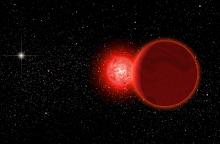Listen to today's episode of StarDate on the web the same day it airs in high-quality streaming audio without any extra ads or announcements. Choose a $8 one-month pass, or listen every day for a year for just $30.
You are here
Moon, Jupiter, Spica
A deceptive arc of three bright celestial objects climbs into good view late this evening: the Moon, the planet Jupiter, and the star Spica.
The deception is that although we see all three of them at the same time, we don’t see all three at the same moment in time. Instead, we’re seeing them as they looked at different moments in the past.
We see the Moon almost in real time. It’s only about a quarter of a million miles away — a bare hop by astronomical standards. At that range, it takes light — moving at 186,000 miles every second — less than a second and a half to reach Earth.
Brilliant Jupiter, which is below the Moon, is also quite close as astronomical objects go — about 450 million miles. At lightspeed, that’s just 40 minutes away. So as you look at Jupiter tonight, you’re seeing the giant planet as it appeared about 40 minutes earlier.
Fainter Spica, to the lower right of Jupiter, is much farther away — about 250 light-years. So we’re seeing it as it looked around the year 1767, give or take a decade or so — shortly before a young Alexander Hamilton first arrived in the American colonies.
All the other stars that are visible in the night sky range from a few light-years away to a few thousand. So the starry firmament isn’t like lights on a great dome, as our ancestors thought. Instead, it’s a 3-D extravaganza — a sparkling array of lights scattered in time as well as space.
Script by Damond Benningfield





